Содержание
- 2. What is Access Control? Access Control is a security term used to refer to a set
- 3. Information Access Control Information access control restricts access to data. Some examples include: a user signing
- 4. Authentication and Authorization Authentication is the security practice of confirming that someone is who they claim
- 5. Types of Access Control Correct configuration of access privileges is a critical component of protecting information.
- 6. Discretionary Access Control (DAC) Each user is given appropriate access rights (or privileges) on specific database
- 7. What is a privilege? Privileges are the actions that a user is permitted to carry out
- 8. Possible privileges The main privileges defined by the ISO standard are: SELECT – the privilege to
- 9. GRANT The GRANT statement is used to grant privileges on database objects to specific users. The
- 10. GRANT example PrivilegeList consists of one or more of the following privileges separated by commas. ObjectName
- 11. ALL PRIVILEGES For convenience, the GRANT statement allows the keyword ALL PRIVILEGES to be used to
- 12. PUBLIC It also provides the keyword PUBLIC to allow access to be granted to all present
- 13. WITH GRANT OPTION The WITH GRANT OPTION clause allows the user(s) in AuthorizationIdList to pass the
- 14. REVOKE The REVOKE statement is used to take away privileges that were granted with the GRANT
- 15. REVOKE example So, if we wanted to remove the DELETE privilege from vinny on the member
- 16. GRANT/ REVOKE with ROLE Add users in the role (group) with: GRANT group_role TO role1, ...
- 17. Books Connolly, Thomas M. Database Systems: A Practical Approach to Design, Implementation, and Management / Thomas
- 18. Protection of DBMS LECTURE 4 Data Control Language IITU, ALMATY
- 19. Access Control Thus far, we are the only users that interact with the databases that we
- 20. DBA A database administrator (DBA) is the “super-user” of a database. A DBA can access and
- 21. SQL Structure DDL (Data Definition Language) DML (Data Manipulation Language) TCL (Transaction Control Language) DCL (Data
- 22. DCL statements SQL DCL provides the facility to create users, grant privileges to users, and revoke
- 23. CREATE USER To create a user we must tell the DBMS the user’s username and password.
- 24. CREATE ROLE and CREATE USER CREATE USER is now an alias for CREATE ROLE. The only
- 25. CREATE ROLE CREATE ROLE defines a new database role Role is an entity that can own
- 26. CREATE ROLE CREATE ROLE name [ [ WITH ] option [ ... ] ] where option
- 27. CREATE ROLE options SUPERUSER | NOSUPERUSER These clauses determine whether the new role is a "superuser",
- 28. CREATE ROLE options INHERIT | NOINHERIT These clauses determine whether a role "inherits" the privileges of
- 29. CREATE ROLE options CONNECTION LIMIT connlimit If role can log in, this specifies how many concurrent
- 30. CREATE ROLE options IN ROLE role_name [, …] The IN ROLE clause lists one or more
- 31. CREATE ROLE examples Create a role with a password: CREATE ROLE davide WITH LOGIN PASSWORD ‘jw8s0F4';
- 32. DROP ROLE DROP ROLE removes the specified role(s). To drop a superuser role, you must be
- 33. ALTER ROLE ALTER ROLE role_specification [ WITH ] option [ ... ] where option can be:
- 34. Books Connolly, Thomas M. Database Systems: A Practical Approach to Design, Implementation, and Management / Thomas
- 35. Protection of DBMS LECTURE 2 Views IITU, ALMATY
- 36. View View is a virtual table based on the result-set of an SQL statement. View contains
- 37. View Views do not physically exist. Views are virtual tables. You can add SQL functions, WHERE,
- 38. Use of view: case 1 In some cases, we may not want users to see all
- 39. Use of view: case 2 In other case, a complex set of relational tables does not
- 40. Use of views Views allow users to do the following: Restrict access to the data such
- 41. CREATE VIEW A view is created using the CREATE VIEW SQL command with SELECT on the
- 42. CREATE OR REPLACE VIEW CREATE OR REPLACE VIEW is similar, but if a view of the
- 43. CREATE VIEW example To create a view Students_info with only first and last names from the
- 44. CREATE OR REPLACE VIEW Syntax: CREATE OR REPLACE VIEW view_name AS SELECT …; Example: CREATE OR
- 45. DROP VIEW Views can be deleted with the DROP VIEW statement. To delete the Students_groups view
- 46. View with join Views may also be built by joining many tables. To create a view
- 47. View updating Updates to views are not simple. Recall that views are virtual tables – they
- 48. View updating For a view to be updatable, the DBMS must be able to trace any
- 49. View updating Use UPDATE SQL DML command to update the Students_info view: UPDATE Students_info SET fname
- 50. Migration Suppose we slightly altered the view to include only students with group_id = 2. CREATE
- 51. Migration One problem with updatable views are the rows that we attempt to insert may violate
- 52. Using views as physical tables Views can be used like any other real tables in DB.
- 53. Database Security: Access Control The view mechanism provides a powerful and flexible security mechanism by hiding
- 54. Summary A view is the dynamic result of one or more relational operations operating on the
- 55. Summary Views can represent a subset of the data contained in a table. A view can
- 56. Books Connolly, Thomas M. Database Systems: A Practical Approach to Design, Implementation, and Management / Thomas
- 57. Protection of DBMS LECTURE 1 Introduction IITU, ALMATY
- 58. Course Information Lectures Lab works (individual work, University database) Project (teams of 1-2 students, individual topic)
- 59. DBMS Security Data is a valuable resource that must be strictly controlled and managed. Corporate data
- 60. Today’s lecture This lecture describes the scope of database security. We discuss why organizations must take
- 61. Database Security Database Security - mechanisms that protect the database against intentional or accidental threats. Security
- 62. Database Security Effective security requires appropriate controls, which are defined in specific system objectives. The need
- 63. Risk situations Database represents an essential corporate resource that should be properly secured using appropriate controls.
- 64. Theft and fraud Theft and fraud affect not only the database environment but also the entire
- 65. Confidentiality and Privacy Confidentiality refers to the need to maintain secrecy over data, but usually only
- 66. Loss of data integrity Loss of data integrity results in invalid or corrupted data, which may
- 67. Loss of availability Loss of availability means that the data, or the system, or both cannot
- 68. Threats Threat - any situation or event, whether intentional or accidental, that may adversely affect a
- 69. Threats Examples of various threats with areas on which they may have an impact.
- 70. Threats Organization's security depends on the availability of countermeasures and an action plan. For example, if
- 71. Classifications of Threats by purpose of threat implementation by the origin of a threat by localization
- 72. 1. Classification by purpose of threat implementation Violation of the confidentiality of information use of information
- 73. 2. Classification by the origin of a threat Natural threats threats caused by the impact on
- 74. 3. Classification by localization of threat source Threats, a direct source of which is a human
- 75. 4. Classification by location of threat source Threats, the source of which is located outside the
- 76. 5. Classification by way of impact on a data storage of the IS Threat of information
- 77. 6. Classification by the nature of the impact on the IS Active impact user actions that
- 78. Example Movie: The Social Network (2010) Hacking Scene: ~ 9 - 12 min
- 79. Example: Classification
- 80. Books Connolly, Thomas M. Database Systems: A Practical Approach to Design, Implementation, and Management / Thomas
- 81. Summary of potential threats
- 82. Summary Database security aims to minimize losses caused by unacceptable events in a cost-effective way without
- 83. Protection of DBMS LECTURE 10 Backup and Recovery IITU, ALMATY
- 84. Content Backup Recovery (Restore)
- 85. Database Backup Backup is the process of periodically taking a copy of the database to offline
- 86. Database Backup A DBMS should provide the following facilities to assist with recovery: a backup mechanism,
- 87. Database Backup PostgreSQL provides pg_dump and pg_dumpall tools to backup databases. pg_dump - extract a database
- 88. Backup with pgAdmin The pgAdmin provides an intuitive user interface that allows you to backup a
- 89. Backup with pgAdmin First, right mouse click on the University database, and choose the Backup menu
- 90. Backup with pgAdmin Second, enter the output file name and choose the file format.
- 91. Backup formats Plain. Output a plain-text SQL script file. Custom. Output a custom-format archive suitable for
- 92. Backup with pgAdmin pgAdmin backup tool provides various dump options as follows:
- 93. Backup with pgAdmin Third, click Backup button to start performing a backup. pgAdmin provides detailed information
- 94. Recovery Dumps can be output in script or archive file formats. Script dumps are plain-text files
- 95. Recovery In PostgreSQL, you can restore a database in two ways: Using psql to restore plain
- 96. Recovery with pgAdmin If you want to run the recovery via an intuitive user interface instead
- 97. Recovery with pgAdmin First, drop the existing University database. Second, create an empty University database.
- 98. Recovery with pgAdmin Third, choose the University database, right mouse click and choose the Restore menu
- 99. Recovery with pgAdmin Fourth, choose appropriate options such as backed up file, role, restore options, and
- 100. Recovery with pgAdmin Possible restore options:
- 101. Recovery with pgAdmin pgAdmin displays detailed information.
- 102. Сopy DB within the same server While the previous method copies a database from a server
- 103. Сopy DB within the same server For example, to copy the University database to the University_copy
- 104. Сopy DB with pgAdmin Firstly, to create a new database: Databases -> Create -> Database To
- 105. Сopy DB with pgAdmin Resulting SQL script (SQL tab):
- 106. Books Connolly, Thomas M. Database Systems: A Practical Approach to Design, Implementation, and Management / Thomas
- 107. Protection of DBMS LECTURE 11 SQL Injections IITU, ALMATY
- 108. Today’s lecture Embedded SQL SQL injections
- 109. Embedded SQL Embedded SQL is a method of combining the computing power of a programming language
- 110. Embedded SQL We can write SQL statements in code written in a programming languages like Java,
- 111. Embedded SQL
- 112. Embedded SQL Formally, the process of placing an SQL statement within an application to query a
- 113. Embedded SQL Embedded SQL comes in two flavors: static and dynamic. We are familiar with writing
- 114. Embedded SQL Dynamic embedded SQL statements allow to place the value of program variables in queries.
- 115. SQL Injection SQL injection is a code injection technique that might destroy your database. SQL injection
- 116. SQL in Web Pages SQL injection usually occurs when you ask a user for input, like
- 117. Anatomy of an SQL attack SQL Injection Web Application Server SQL Database
- 118. SQL in Web Pages The following example creates a SELECT statement by adding a variable (txtUserId)
- 119. SQL in Web Pages A similar query is generally used from the web application in order
- 120. SQL in Web Pages Here is an example of a user login on a web site:
- 121. SQL injection examples SQL Injection Based on: 1=1 is Always True ' ' = ' '
- 122. 1=1 is Always True The original purpose of the code is to create an SQL statement
- 123. 1=1 is Always True The following SQL is valid and will return ALL rows from the
- 124. 1=1 is Always True SELECT * FROM Users WHERE UserId = 105 OR 1=1 The SQL
- 125. ' ' = ' ' is Always True Here is an example of a user login
- 126. ' ' = ' ' is Always True A hacker might get access to user names
- 127. ' ' = ' ' is Always True The code at the server will create a
- 128. Batched SQL Statements DBMSs support batched SQL statement. A batch of SQL statements is a group
- 129. Batched SQL Statements sql = "SELECT * FROM Users WHERE UserId = " + txtUserId; The
- 130. Reaction You've just detected a SQL injection attack. Your actions: As quickly as possible disable access
- 131. Detection If someone were to start a SQL injection attack against your site right now, would
- 132. Detection In addition to pure SQL errors, permission errors often occur as well, as the attacker
- 133. Detection Sometimes, when the attacker is very good, no SQL errors are generated, and the problems
- 134. Prevention Preventing SQL injection is mostly a matter of following some standard software development practices: Never
- 135. Conclusion If you take a user input through a webpage and insert it into a SQL
- 136. Books Connolly, Thomas M. Database Systems: A Practical Approach to Design, Implementation, and Management / Thomas
- 137. Protection of DBMS LECTURE 9 Database Activity Monitoring IITU, ALMATY
- 138. Statistics Collector PostgreSQL's statistics collector is a subsystem that supports collection and reporting of information about
- 139. Viewing Statistics When using the statistics to monitor collected data, it is important to realize that
- 140. pg_stat_activity pg_stat_activity belongs to Dynamic Statistics Views. One row per server process, showing information related to
- 141. pg_stat_activity
- 142. pg_stat_activity (cont)
- 143. pg_stat_database pg_stat_database belongs to Collected Statistics Views. One row per database, showing database-wide statistics.
- 144. pg_stat_database
- 145. pg_stat_all_tables pg_stat_all_tables belongs to Collected Statistics Views. One row for each table in the current database,
- 146. pg_stat_all_tables
- 147. pg_stat_statements The pg_stat_statements module provides a means for tracking execution statistics of all SQL statements executed
- 148. pg_stat_statements The module must be loaded by adding pg_stat_statements to shared_preload_libraries in postgresql.conf, because it requires
- 149. pg_stat_statements: step 1 postgresql.conf : BEFORE AFTER
- 150. pg_stat_statements: step 2 Then you need to restart the database server. After that in the database,
- 151. pg_stat_statements For security reasons, non-superusers are not allowed to see the SQL text or queryid of
- 152. pg_stat_get_activity() pg_stat_get_activity(integer) returns a record of information with the specified PID, or one record for each
- 153. Server Signaling Functions The question now is this: once you have found bad queries, how can
- 154. pg_cancel_backend() The pg_cancel_backend function will terminate the query but will leave the connection in place. pg_cancel_backend(pid)
- 155. pg_terminate_backend() The pg_terminate_backend function is a bit more radical and will kill the entire database connection
- 156. Books Connolly, Thomas M. Database Systems: A Practical Approach to Design, Implementation, and Management / Thomas
- 157. Protection of DBMS LECTURE 8 System Catalogs and Information Functions IITU, ALMATY
- 158. Systems Catalogs The system catalogs are the place where a RDMS stores schema metadata, such as
- 159. Systems Catalogs Syntax: SELECT attribute_name / * FROM catalog_name [WHERE …];
- 160. pg_roles The view pg_roles provides access to information about database roles:
- 161. List of users To show all users: SELECT rolname FROM pg_roles;
- 162. pg_authid / pg_roles The catalog pg_authid contains information about database authorization identifiers (roles). Since this catalog
- 163. pg_auth_members The catalog pg_auth_members shows the membership relations between roles.
- 164. role_table_grants / table_privileges The view role_table_grants identifies all privileges granted on tables or views where the
- 165. role_table_grants example By default, the information schema is not in the schema search path, so you
- 166. pg_database The catalog pg_database stores information about the available databases. Databases are created with the CREATE
- 167. pg_class The catalog pg_class catalogs tables and most everything else that has columns or is otherwise
- 168. pg_attribute The catalog pg_attribute stores information about table columns. There will be exactly one pg_attribute row
- 169. pg_constraint The catalog pg_constraint stores check, primary key, unique, foreign key. Not-null constraints are represented in
- 170. System Information Functions Following slides show functions that extract session and system information. In addition to
- 171. System Information Functions Syntax: SELECT function_name(); Note. Some functions (current_catalog, current_role, current_user, user) have special syntactic
- 172. Current Database Following functions return a name of the current database: SELECT current_catalog; SELECT current_database();
- 173. Current Database SELECT current_catalog;
- 174. Current User Following functions return a name of the current user: SELECT current_user; SELECT user; SELECT
- 175. Current User SELECT current_user;
- 176. Current Version version() function shows PostgreSQL version information: SELECT version();
- 177. Access Privilege Inquiry Functions
- 178. has_table_privilege Function has_table_privilege checks whether a user can access a table in a particular way: has_table_privilege(user,
- 179. has_table_privilege Function has_table_privilege checks whether a user can access a table in a particular way: has_table_privilege(table,
- 180. has_table_privilege Optionally, WITH GRANT OPTION can be added to a privilege type to test whether the
- 181. Books Connolly, Thomas M. Database Systems: A Practical Approach to Design, Implementation, and Management / Thomas
- 182. Protection of DBMS Control Structures IITU, ALMATY
- 183. PL/pgSQL PL/pgSQL (Procedural Language/PostgreSQL) is a procedural programming language supported by the PostgreSQL. PL/pgSQL, as a
- 184. Conditionals IF and CASE statements let you execute alternative commands based on certain conditions. PL/pgSQL has
- 185. IF-THEN IF-THEN statements are the simplest form of IF. The statements between THEN and END IF
- 186. IF-THEN Example:
- 187. IF-THEN-ELSE IF-THEN-ELSE statements add to IF-THEN by letting you specify an alternative set of statements that
- 188. IF-THEN-ELSE Example:
- 189. IF-THEN-ELSIF Sometimes there are more than just two alternatives. IF-THEN-ELSIF provides a convenient method of checking
- 190. IF-THEN-ELSIF
- 191. IF-THEN-ELSIF Example:
- 192. Simple CASE The simple form of CASE provides conditional execution based on equality of operands. The
- 193. Simple CASE
- 194. Simple CASE Example:
- 195. Searched CASE The searched form of CASE provides conditional execution based on truth of Boolean expressions.
- 196. Searched CASE
- 197. Searched CASE Example:
- 198. Loops PostgreSQL provides three loop statements: LOOP WHILE loop FOR loop
- 199. LOOP Sometimes, you need to execute a block of statements repeatedly until a condition becomes true.
- 200. LOOP The LOOP statement (unconditional loop) executes the statements until the condition in the EXIT statement
- 201. Examples
- 202. Example (Fibonacci sequence) In this example, we will use the LOOP statement to develop a function
- 203. Example (Fibonacci sequence) The Fibonacci function accepts an integer and returns the nth Fibonacci number. By
- 204. WHILE loop The WHILE loop statement executes a block of statements until a condition evaluates to
- 205. WHILE loop In the WHILE loop statement, PostgreSQL evaluates the condition before executing the block of
- 206. Example (Fibonacci sequence) We can use the WHILE loop statement to rewrite the Fibonacci function in
- 207. FOR loop for looping through a range of integers The following illustrates the syntax of the
- 208. FOR loop for looping through a range of integers First, PostgreSQL creates an integer variable loop_counter
- 209. FOR loop for looping through a range of integers
- 210. FOR loop for looping through a range of integers The following flowchart illustrates the FOR loop
- 211. Example Loop through 1 to 5 and print out a message in each iteration. The counter
- 212. FOR loop for looping through a query result You can use the FOR loop statement to
- 213. FOR loop for looping through a query result The following function accepts an integer which specifies
- 215. Скачать презентацию
























![CREATE ROLE CREATE ROLE name [ [ WITH ] option](/_ipx/f_webp&q_80&fit_contain&s_1440x1080/imagesDir/jpg/610279/slide-25.jpg)



![CREATE ROLE options IN ROLE role_name [, …] The IN](/_ipx/f_webp&q_80&fit_contain&s_1440x1080/imagesDir/jpg/610279/slide-29.jpg)


![ALTER ROLE ALTER ROLE role_specification [ WITH ] option [](/_ipx/f_webp&q_80&fit_contain&s_1440x1080/imagesDir/jpg/610279/slide-32.jpg)













































































































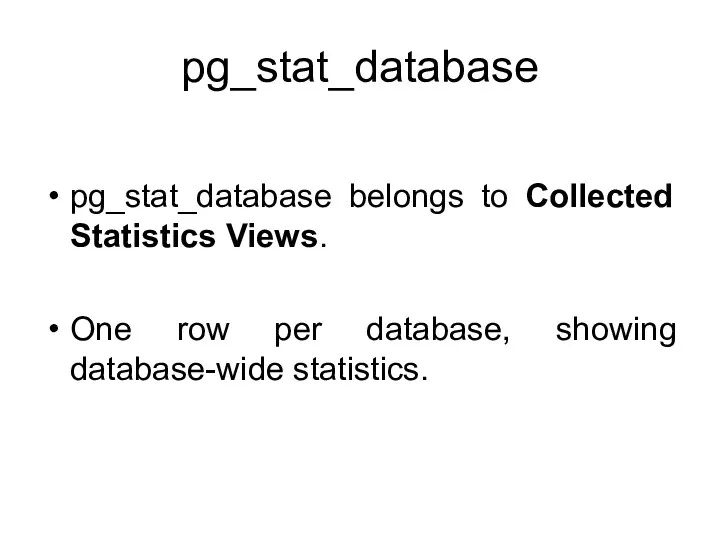
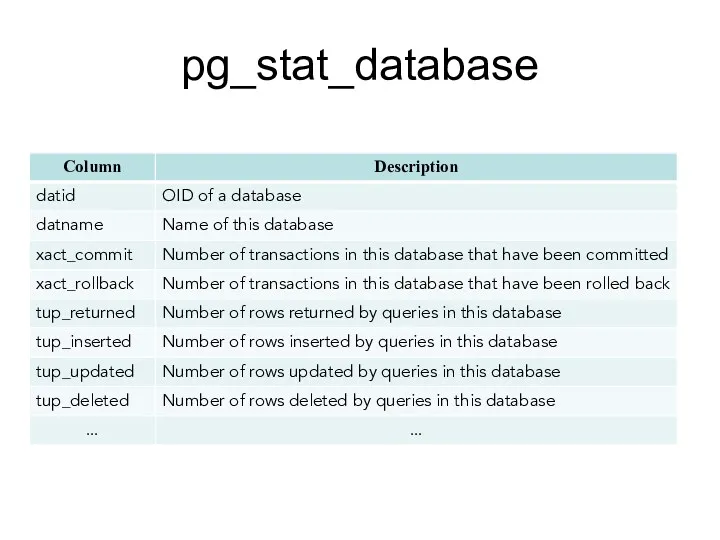

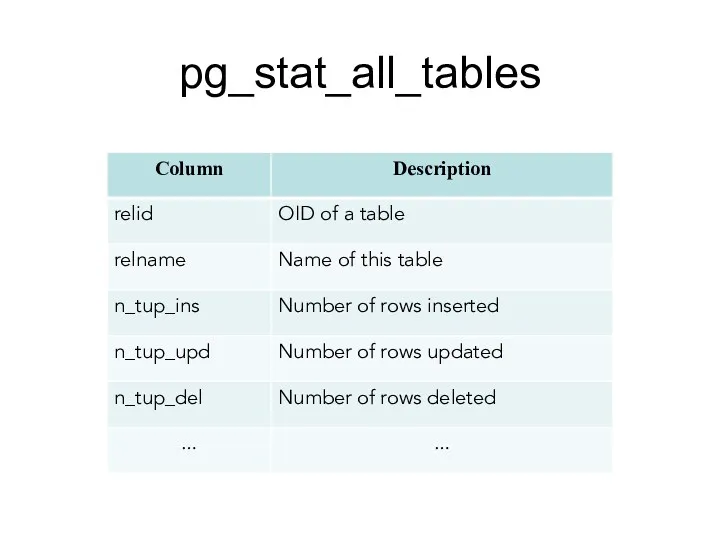
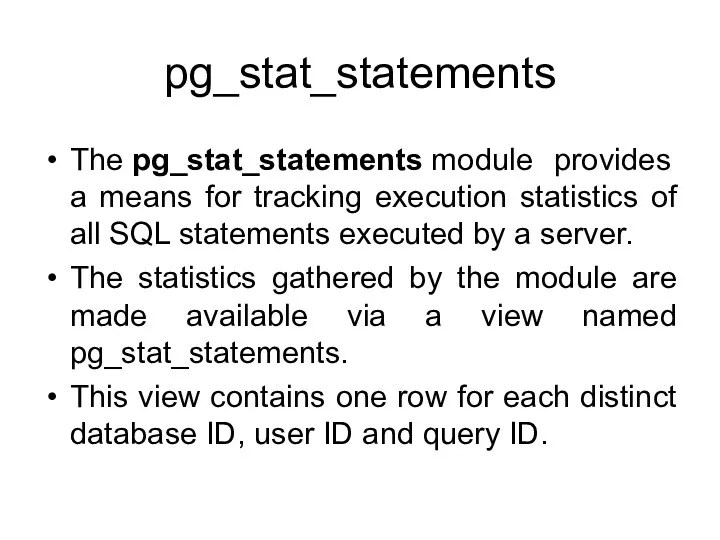
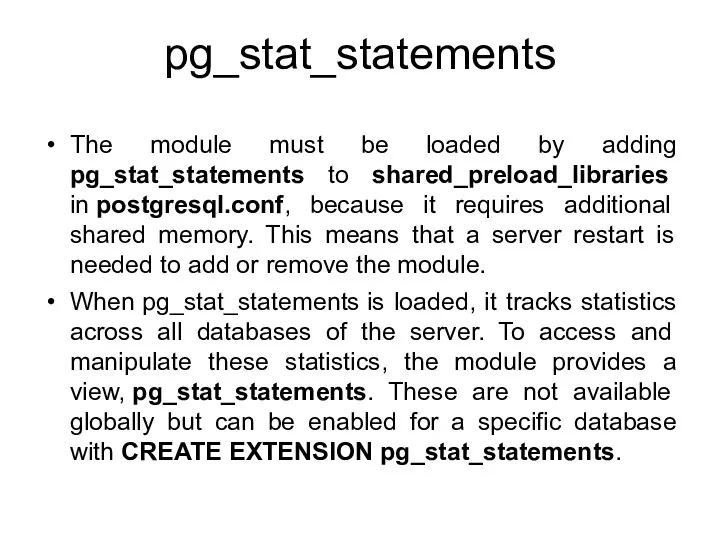
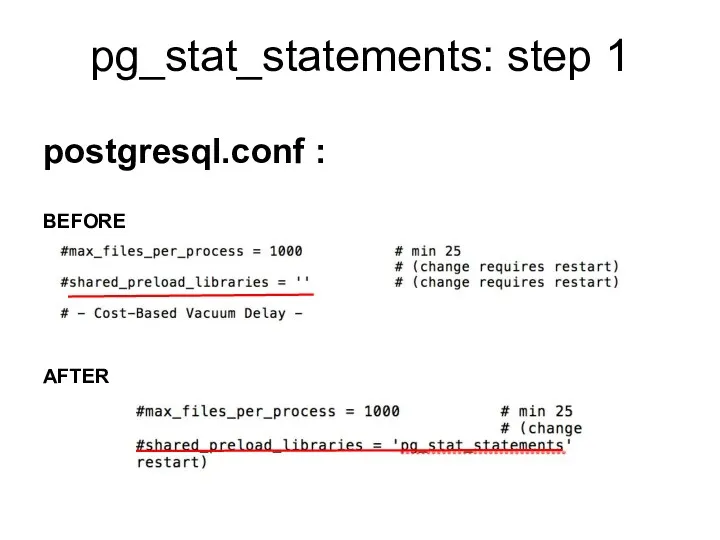
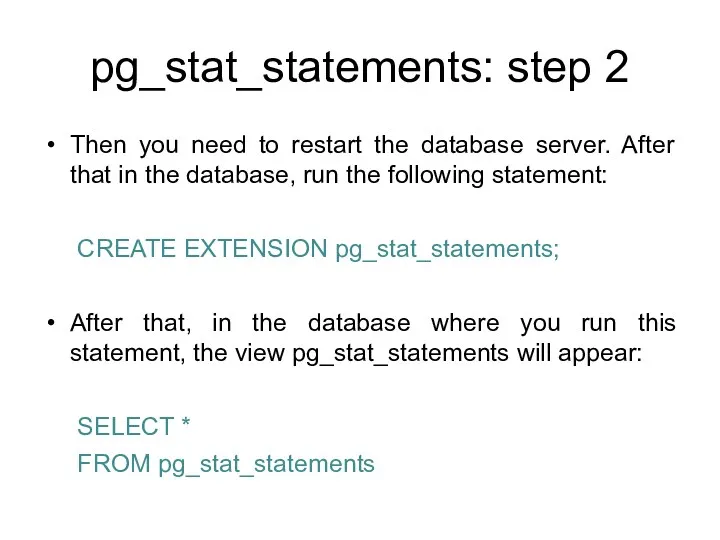
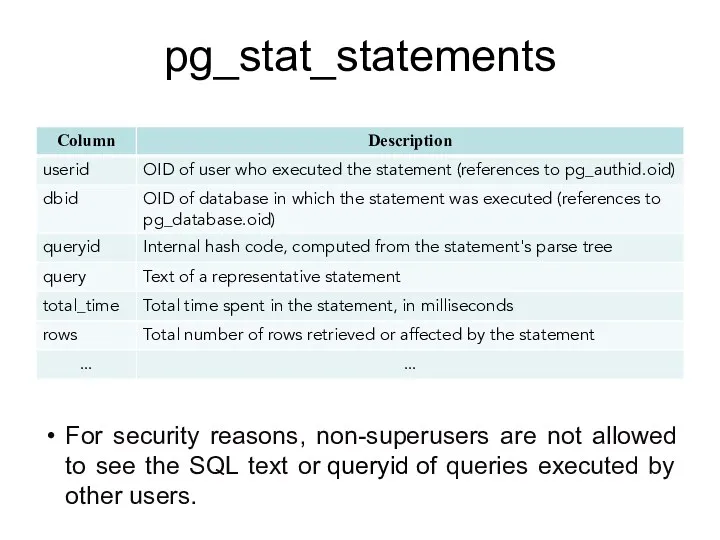
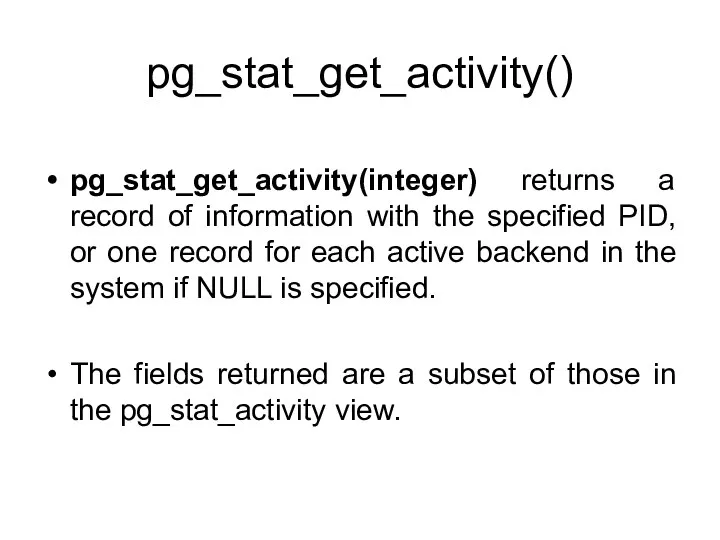
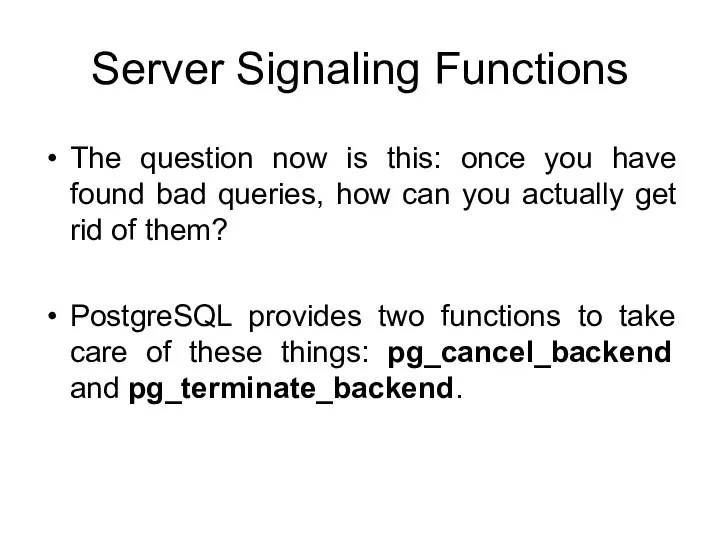
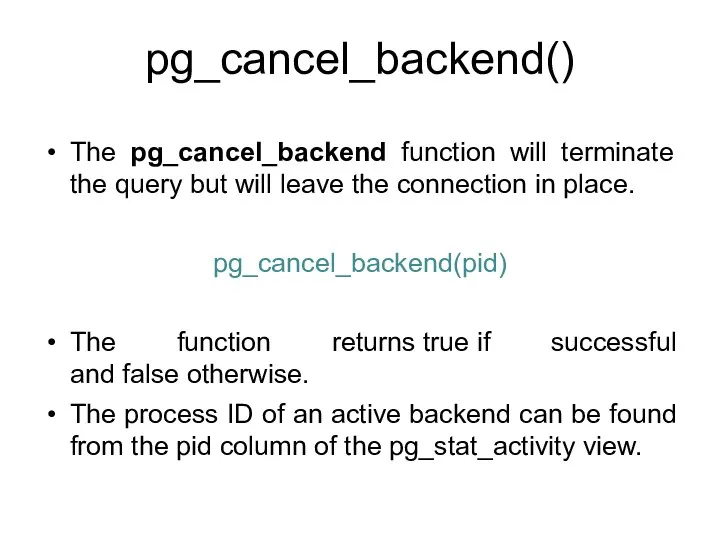
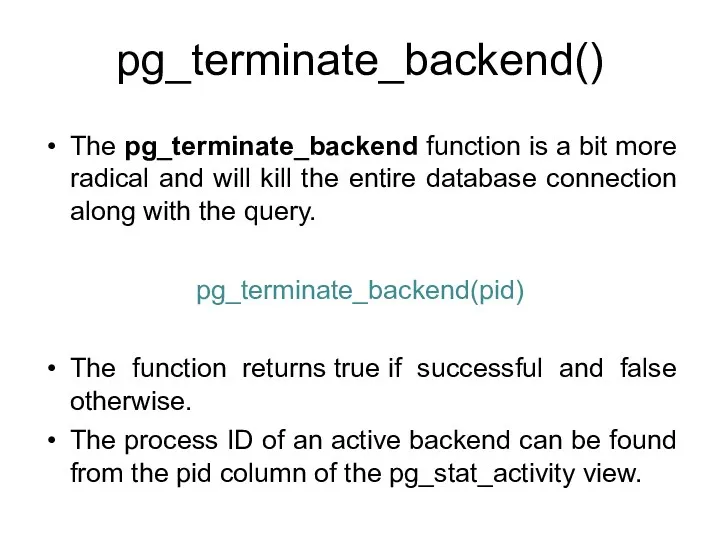

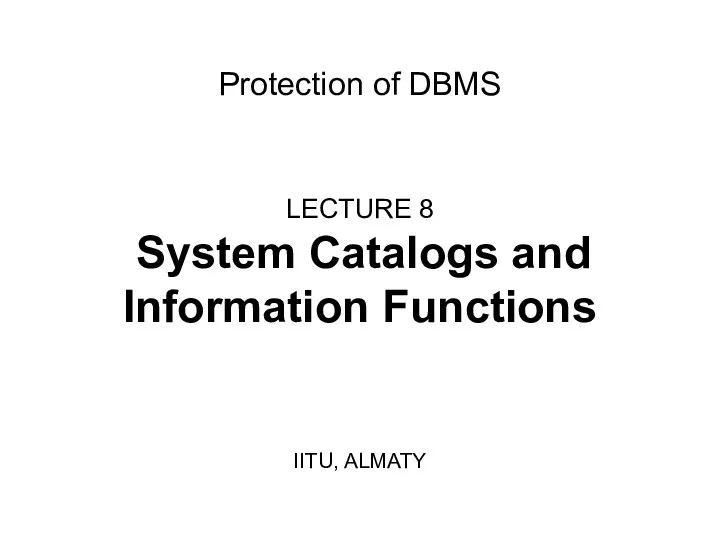
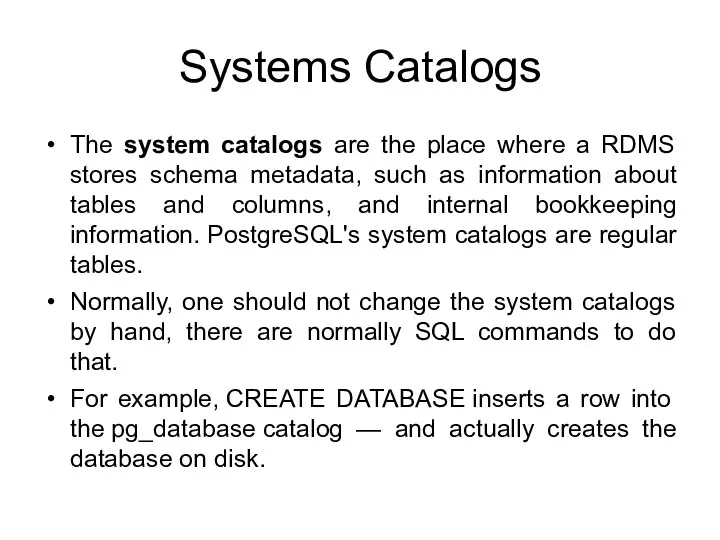
![Systems Catalogs Syntax: SELECT attribute_name / * FROM catalog_name [WHERE …];](/_ipx/f_webp&q_80&fit_contain&s_1440x1080/imagesDir/jpg/610279/slide-158.jpg)
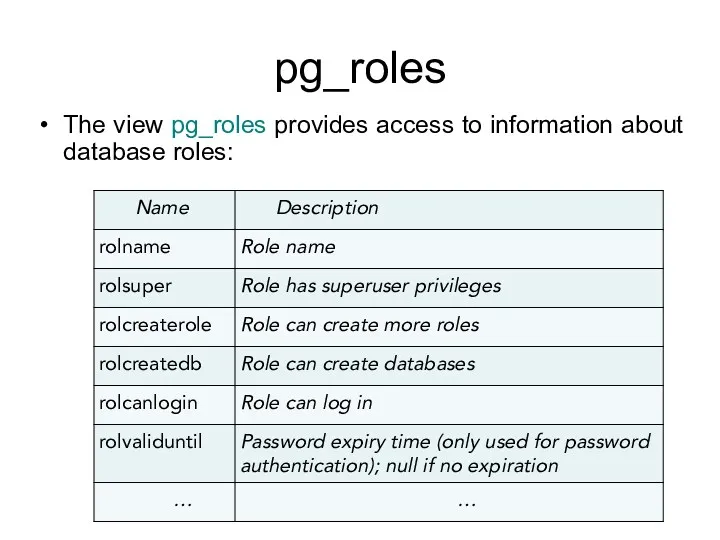

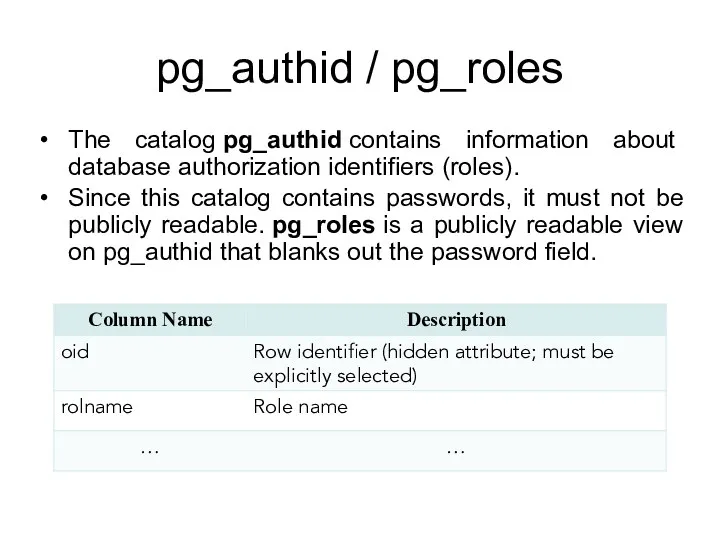
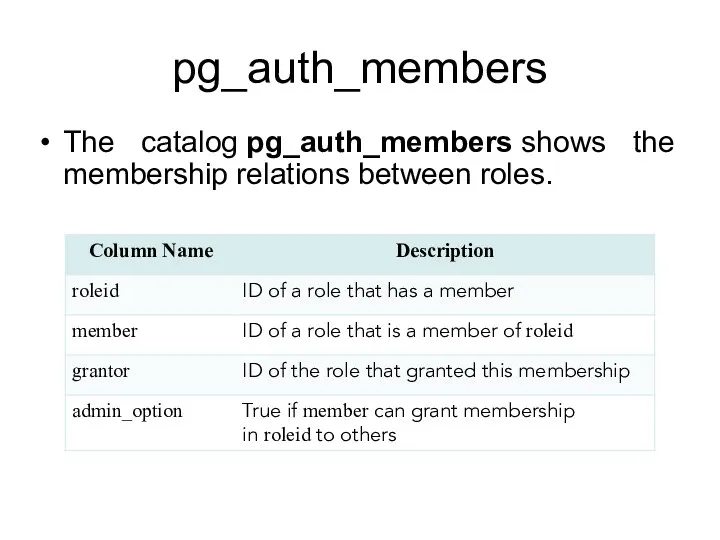
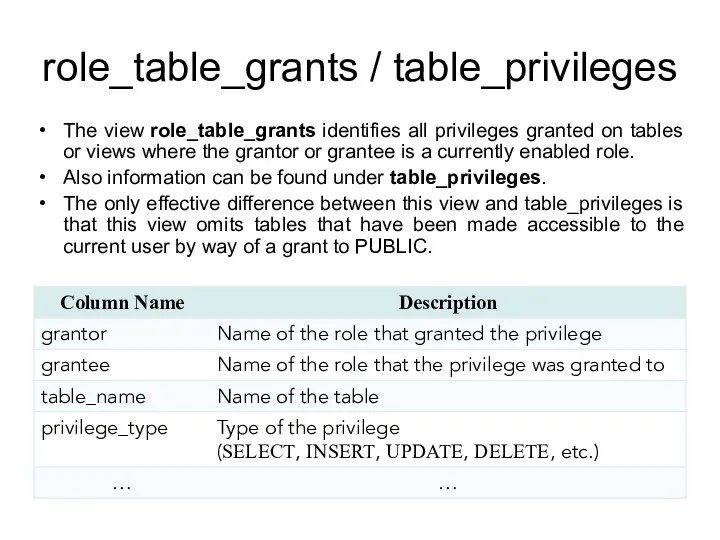
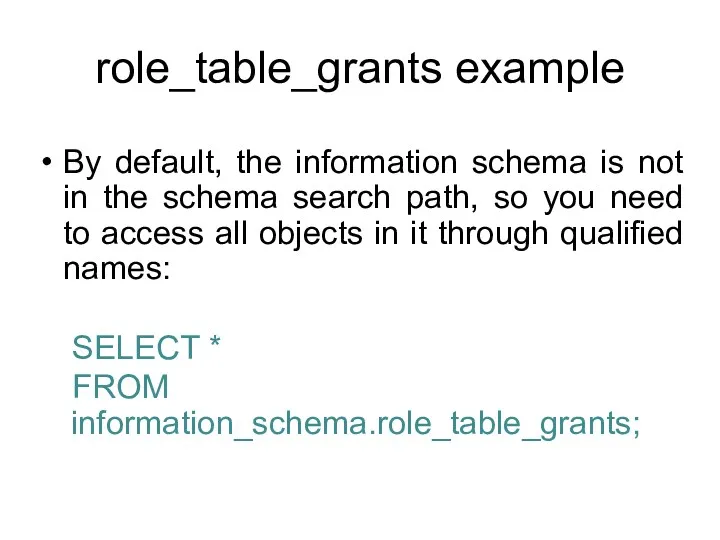
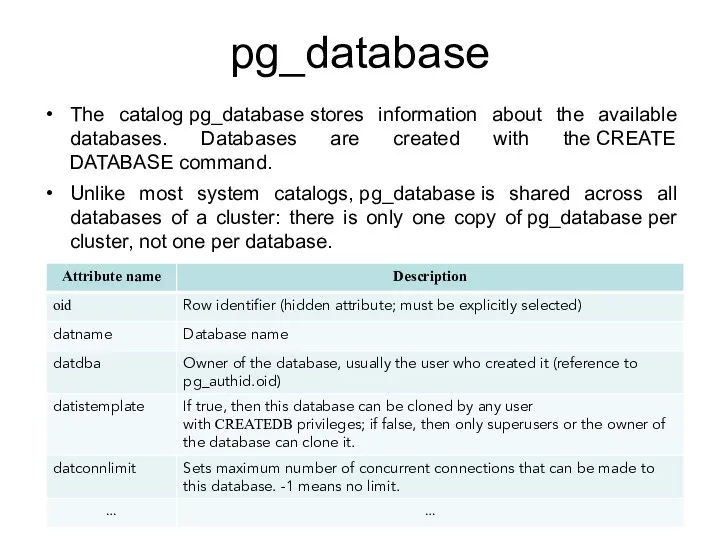
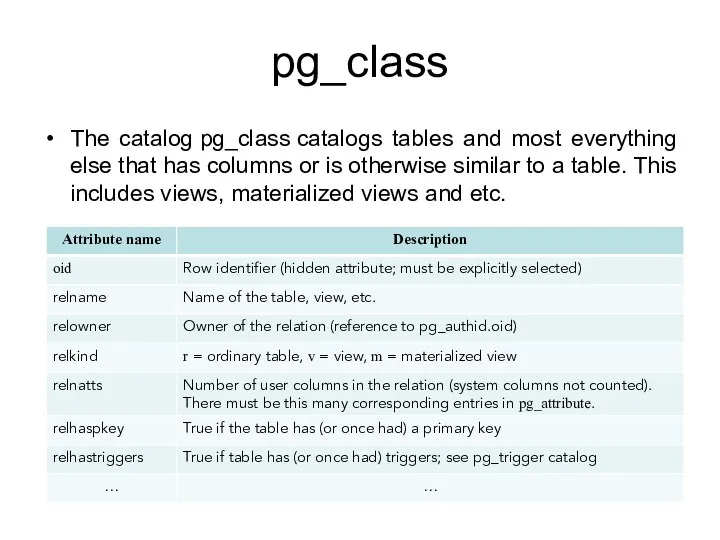
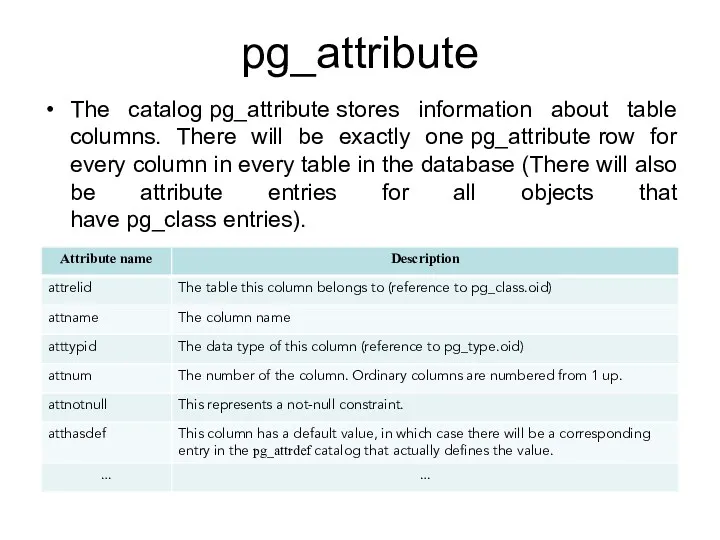
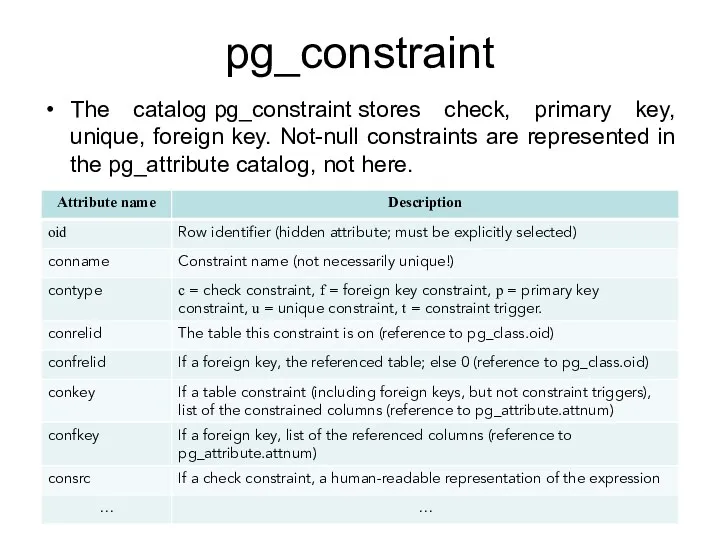
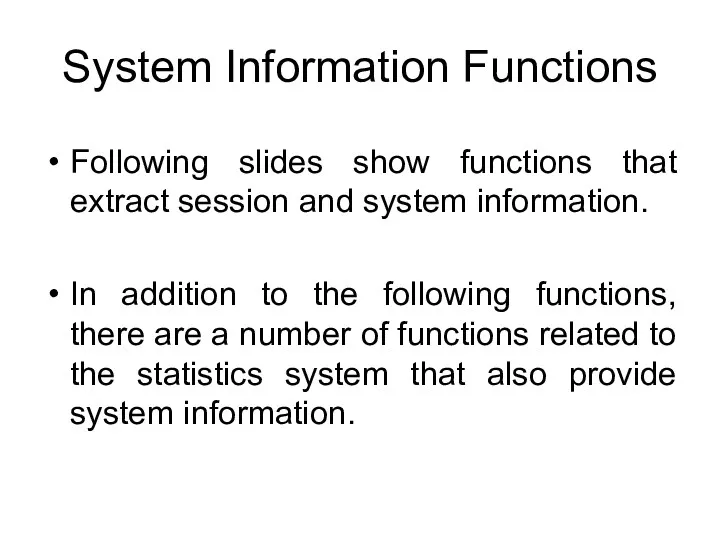
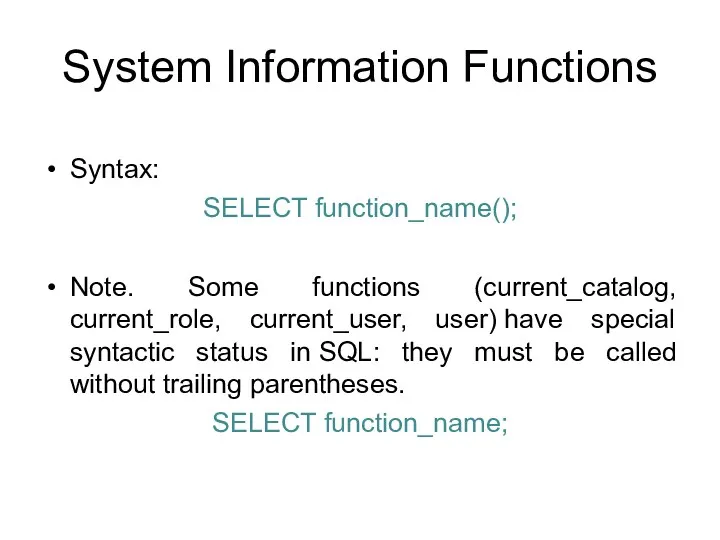
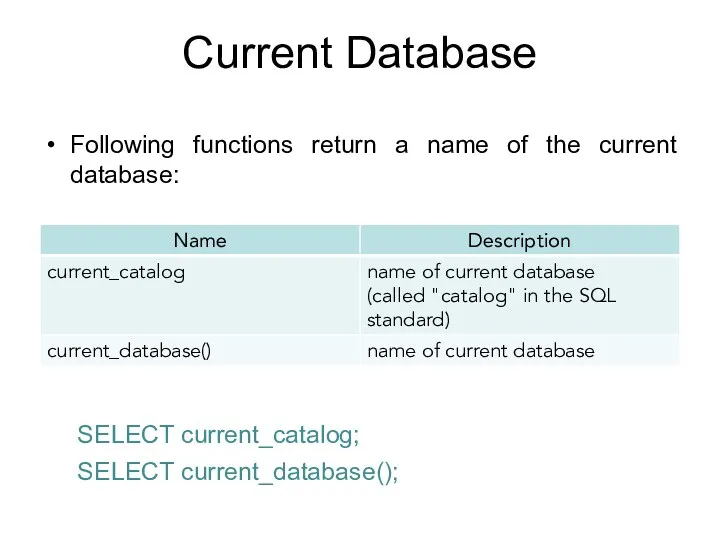
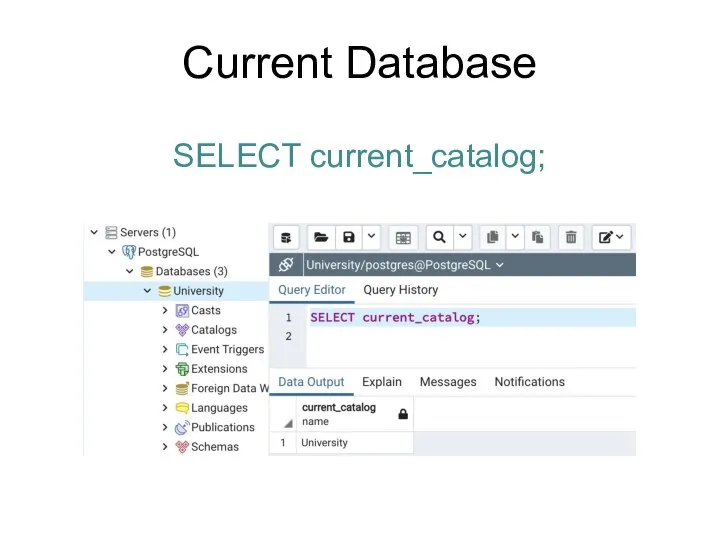
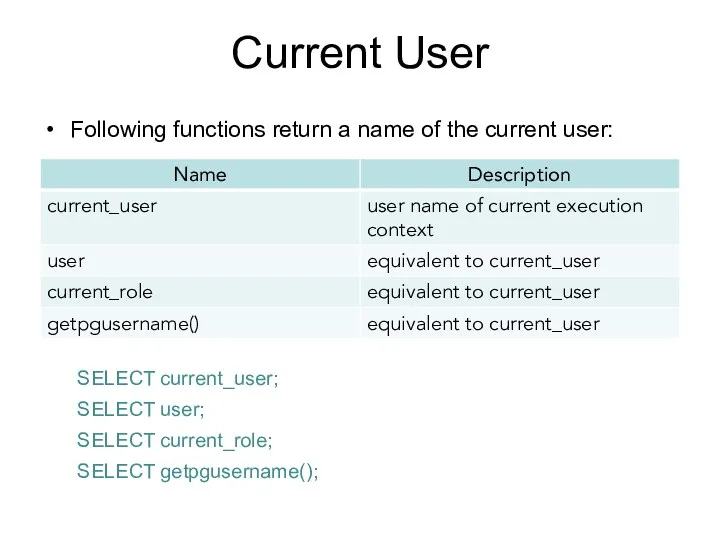
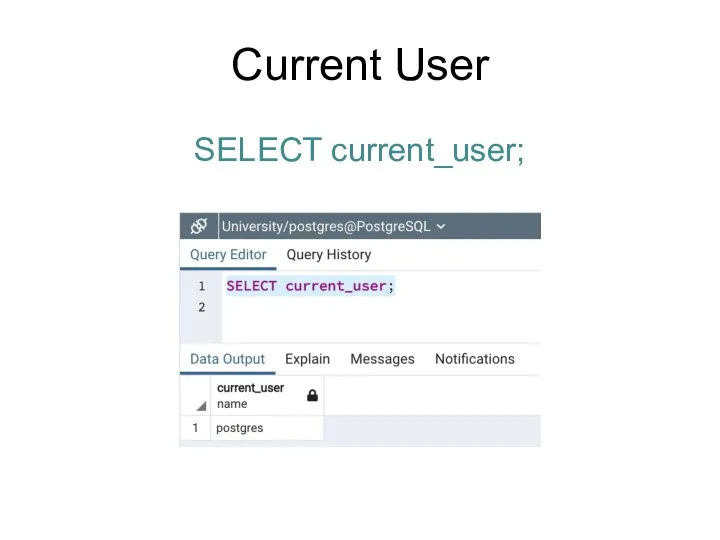
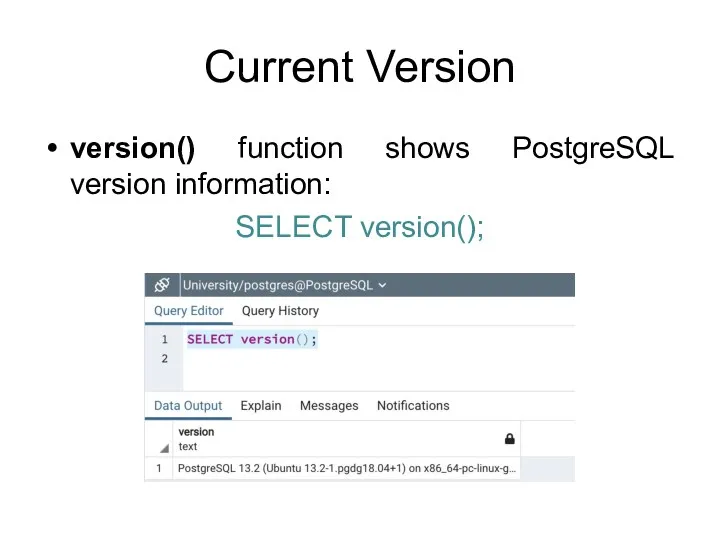
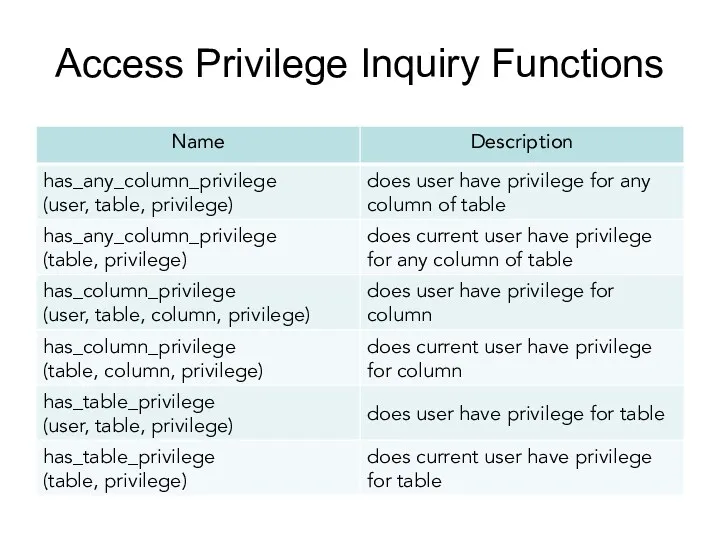
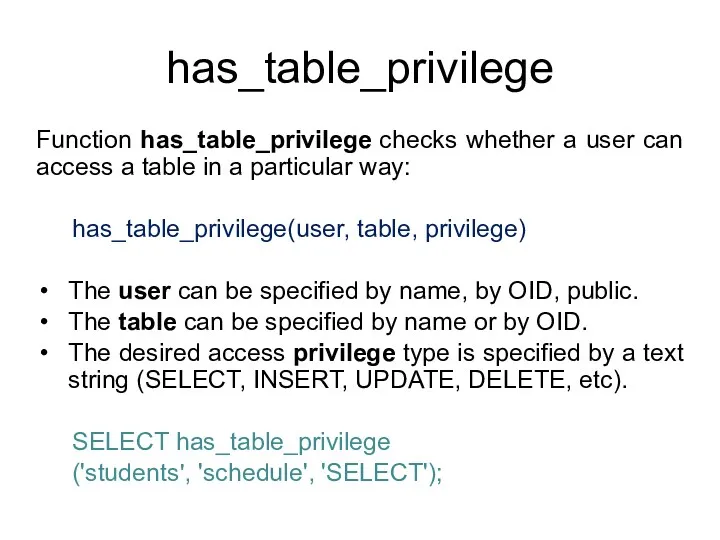
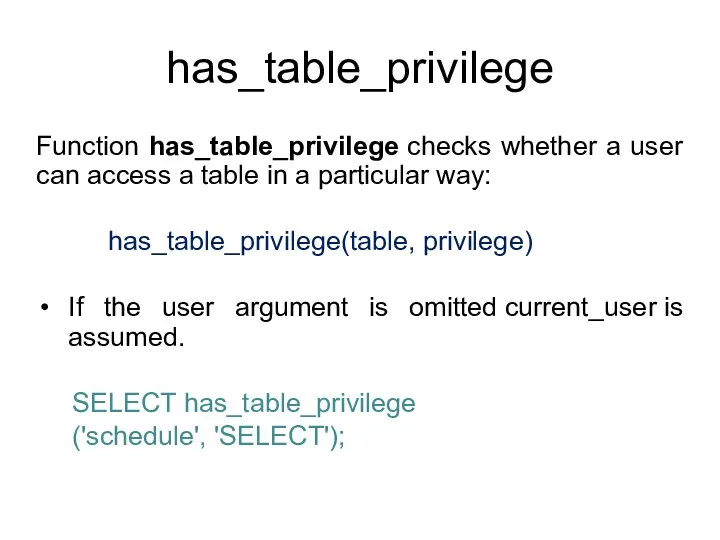
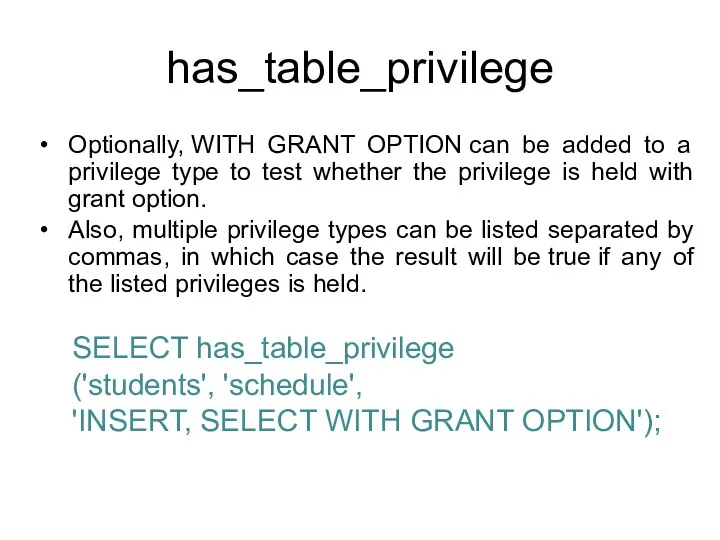

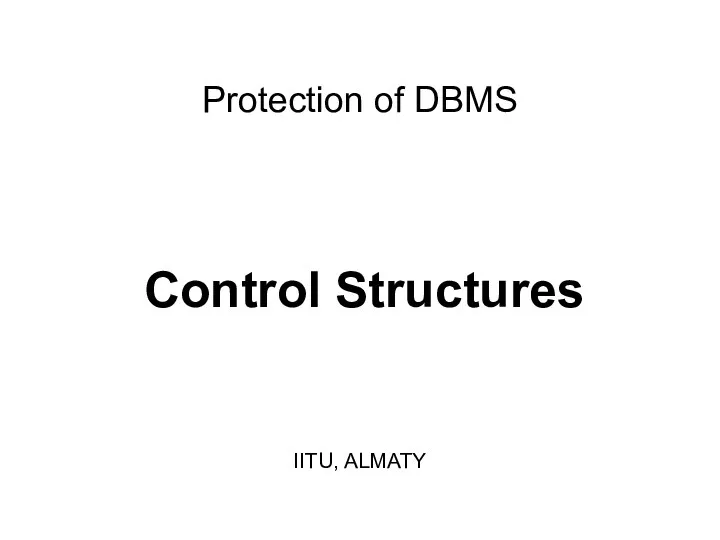
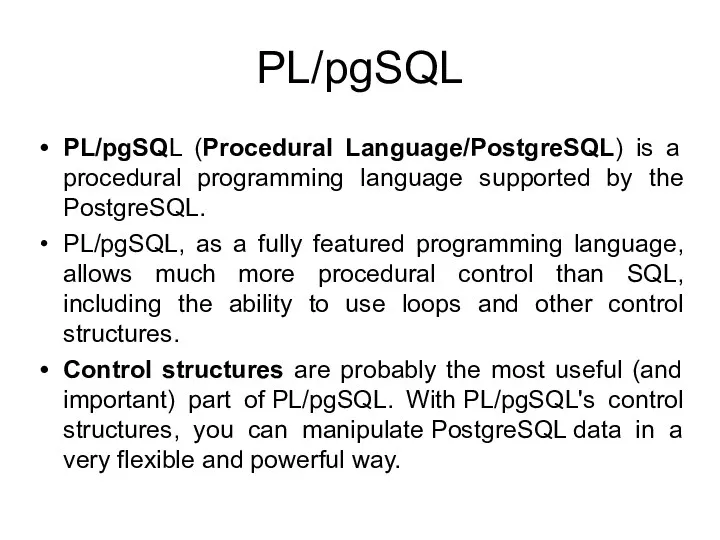
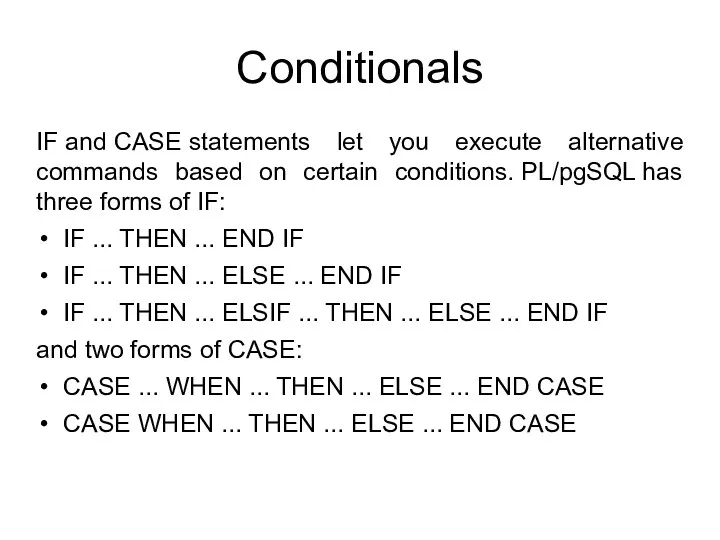
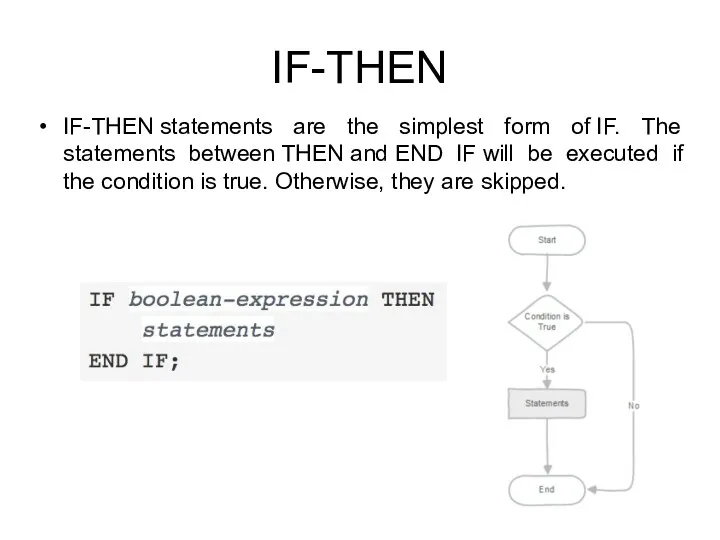
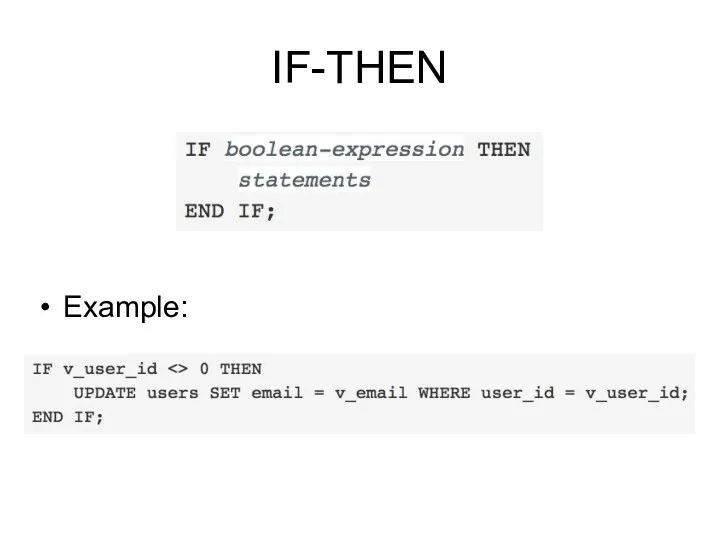
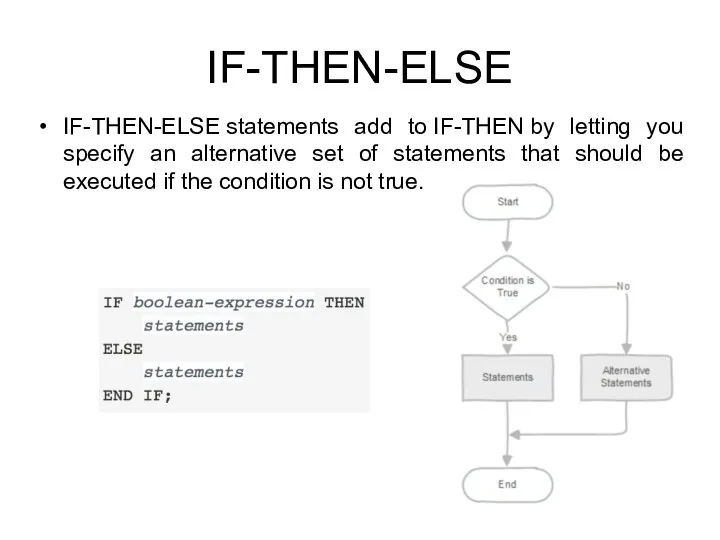
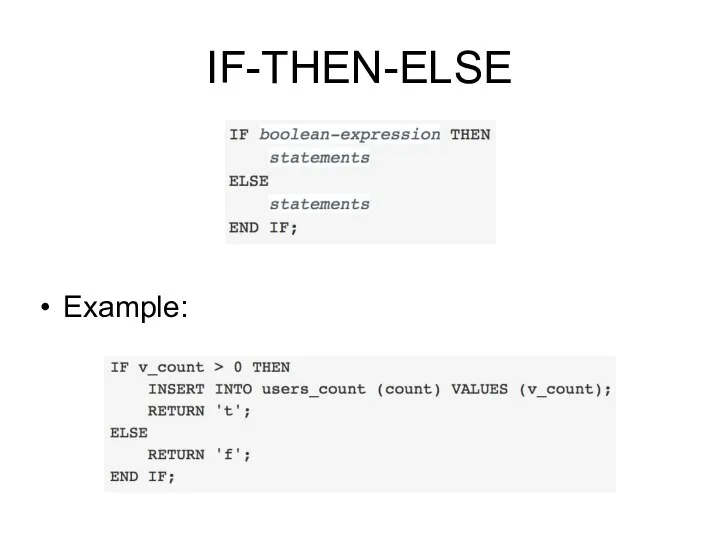
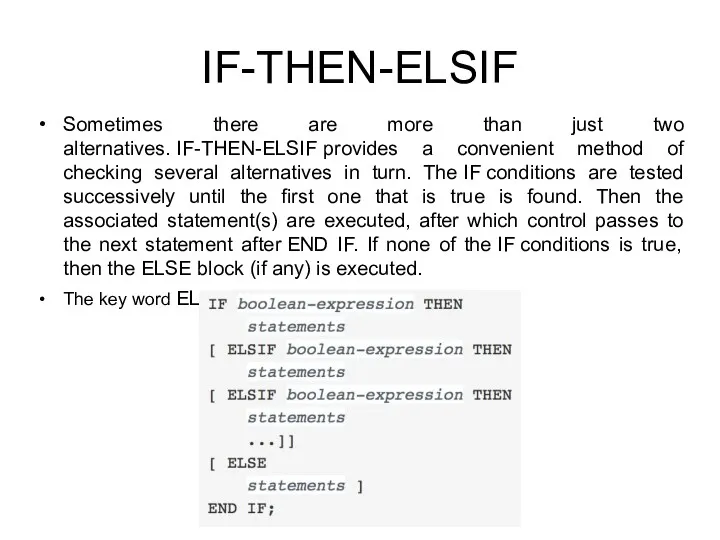
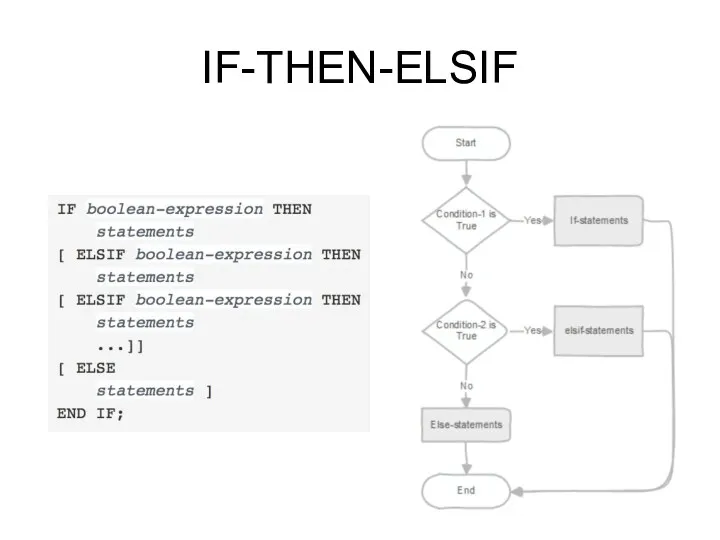
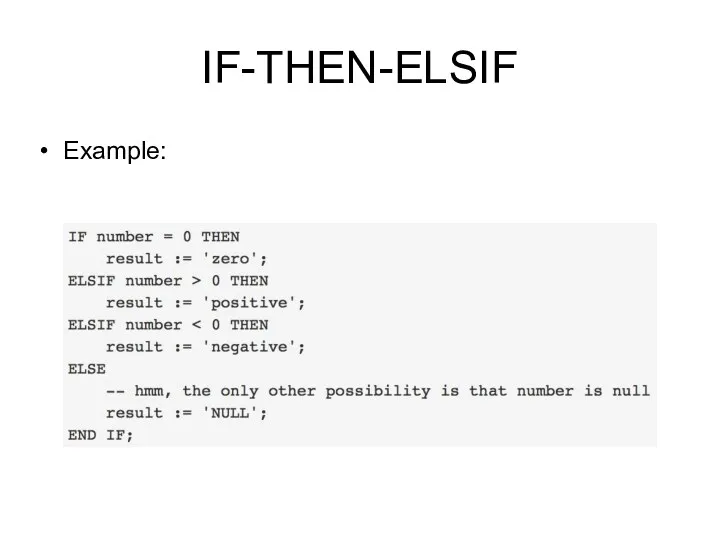
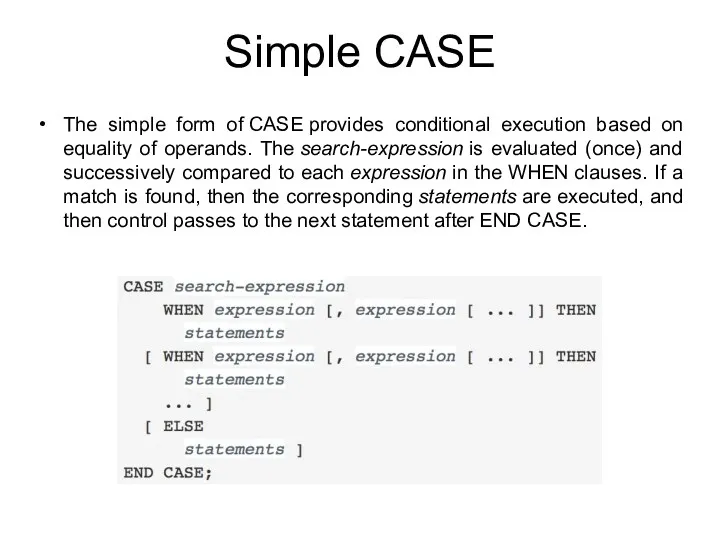
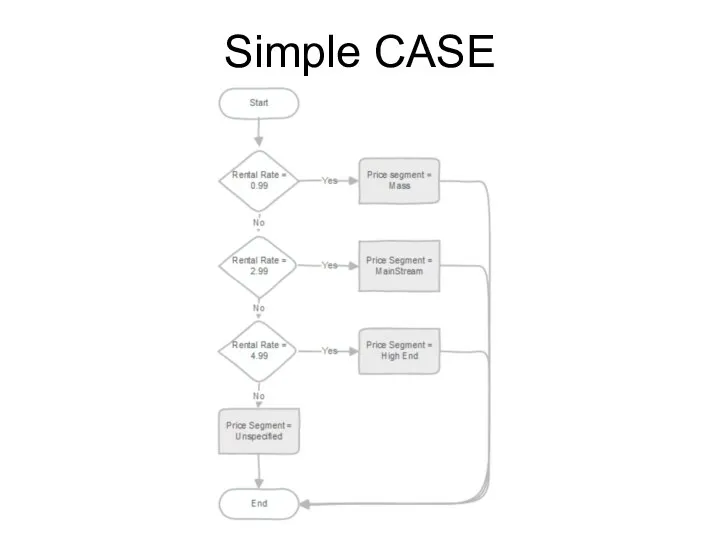
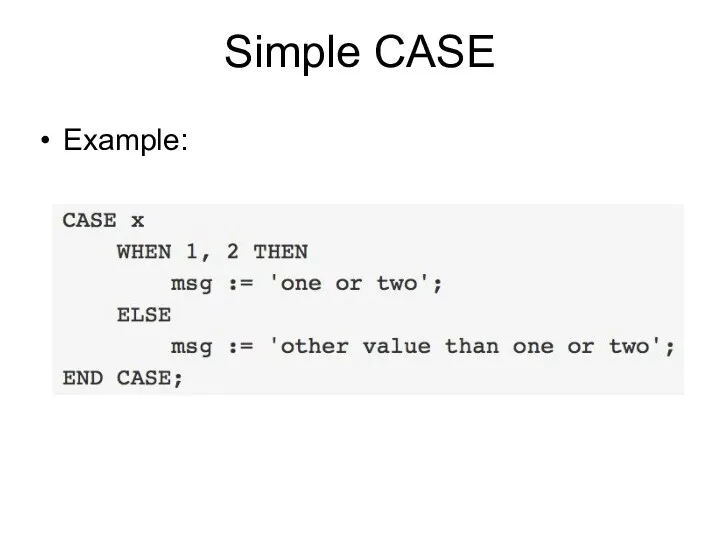
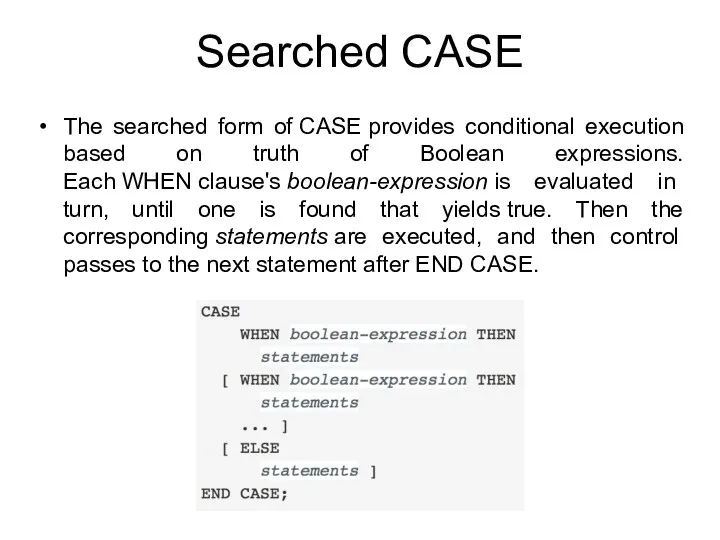
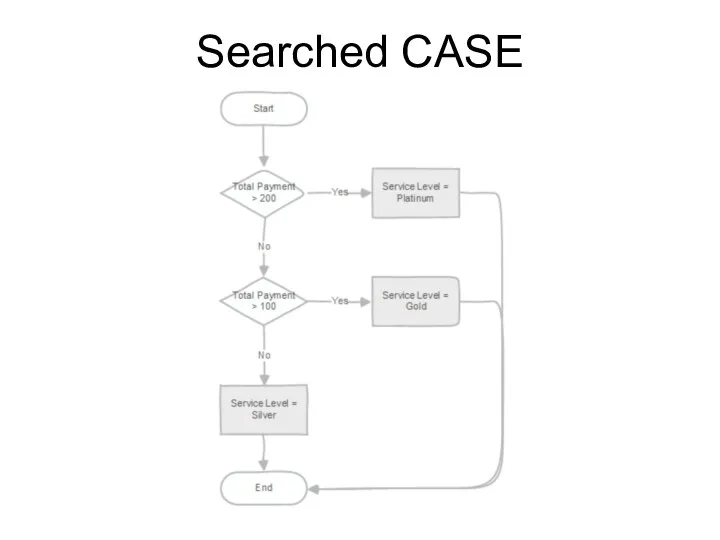
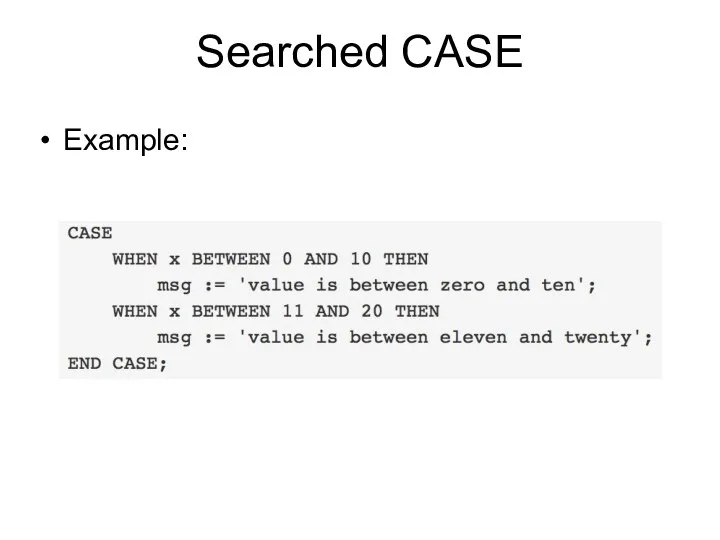
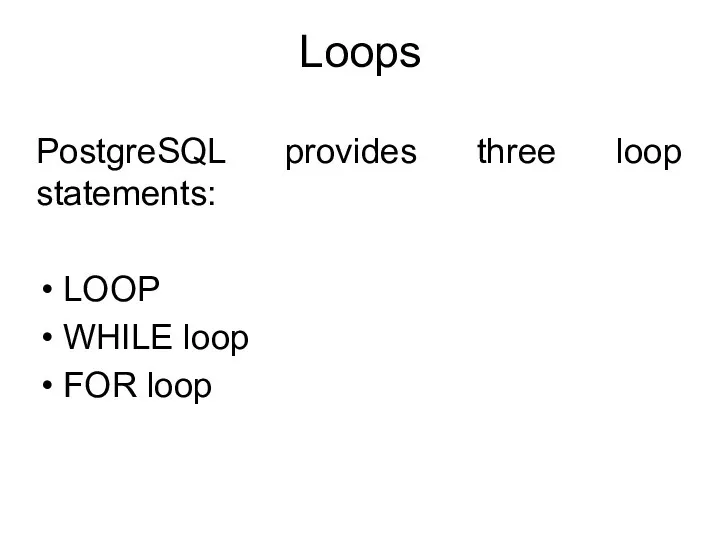
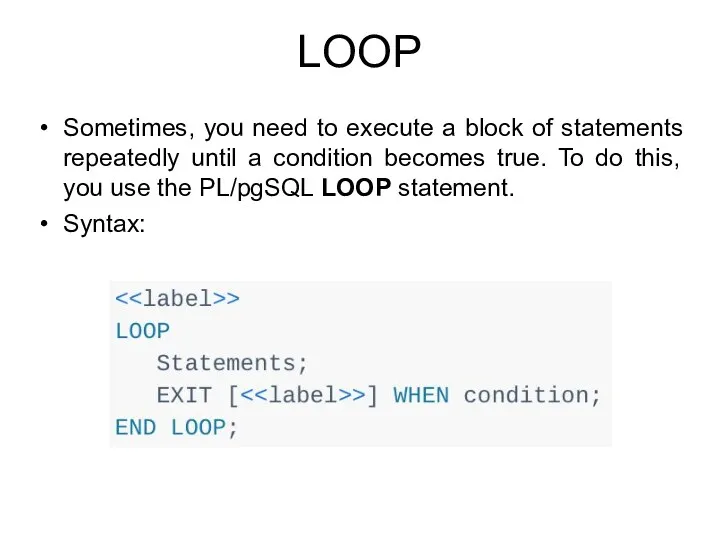
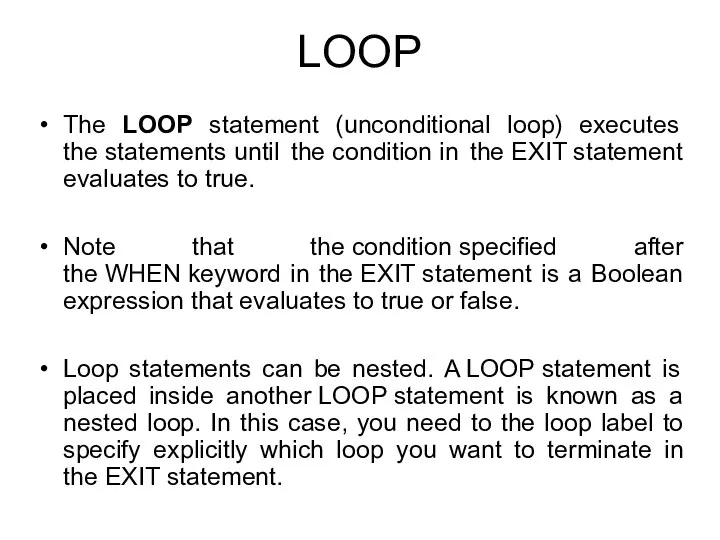
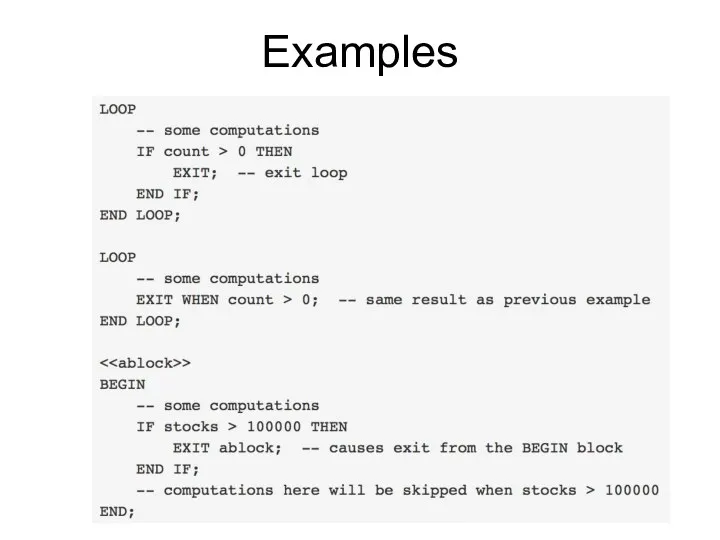
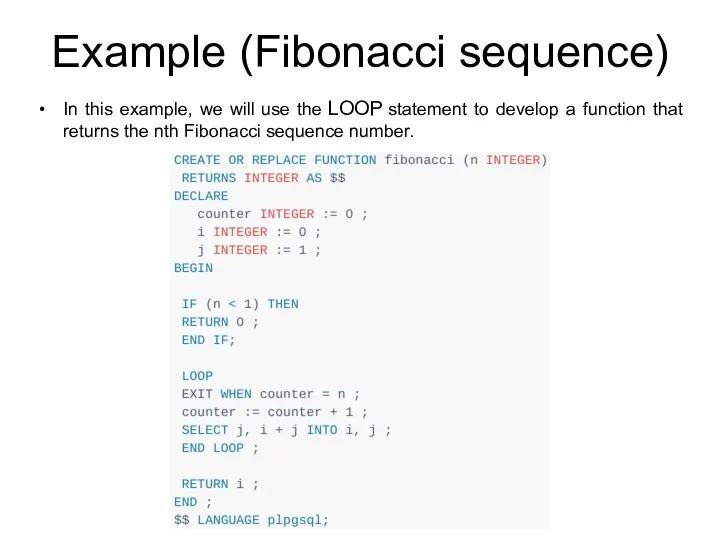
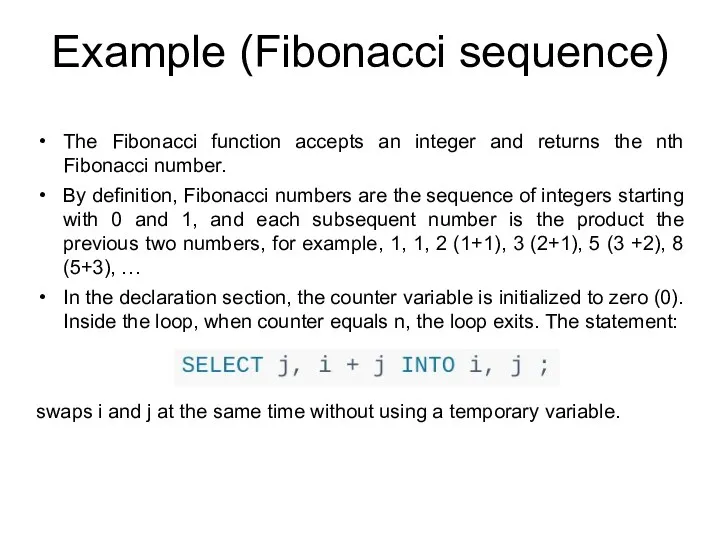
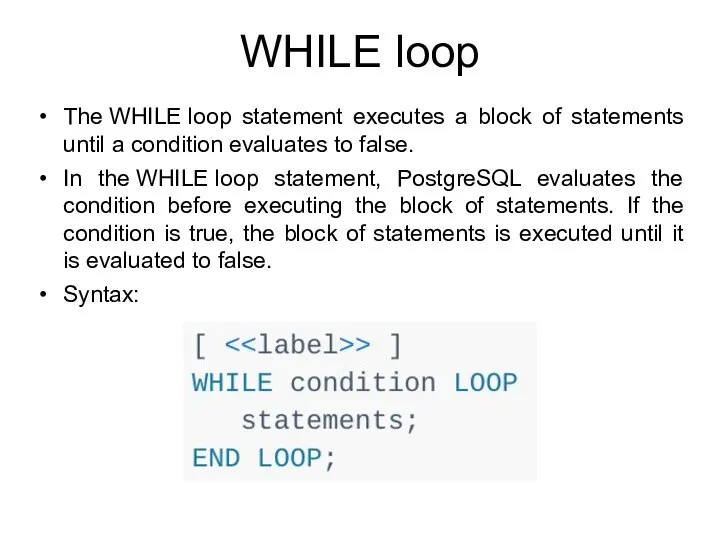
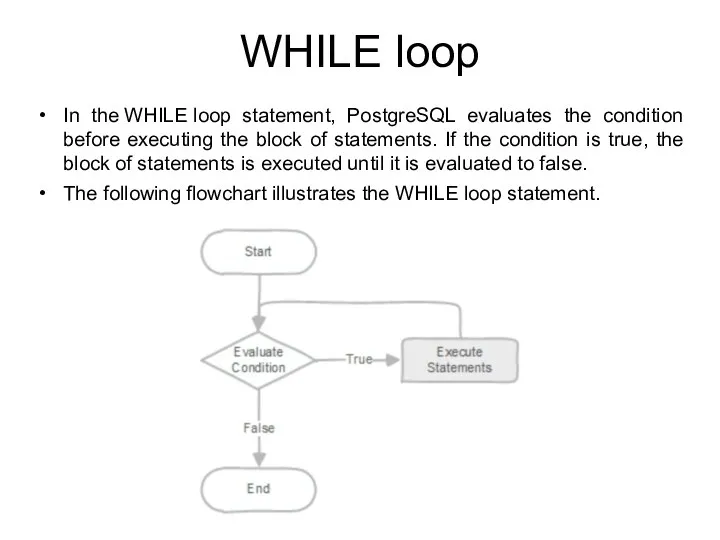
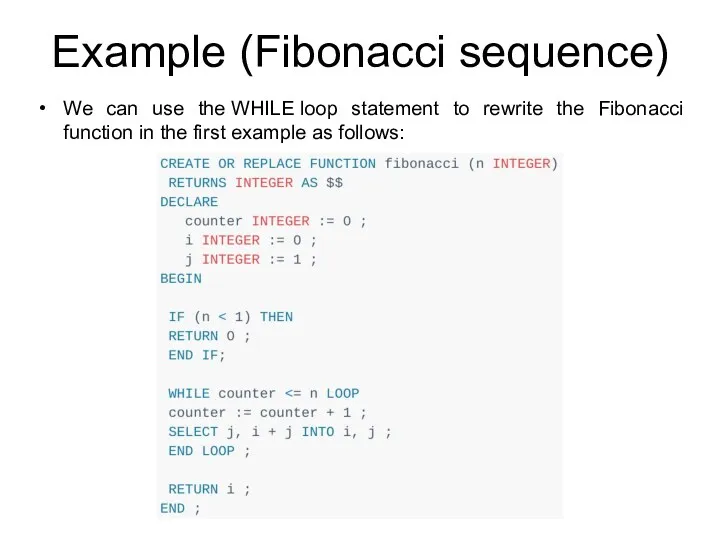
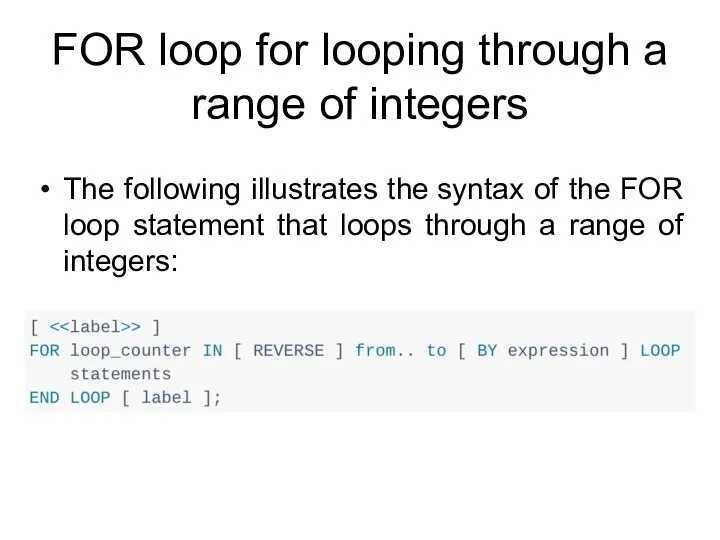
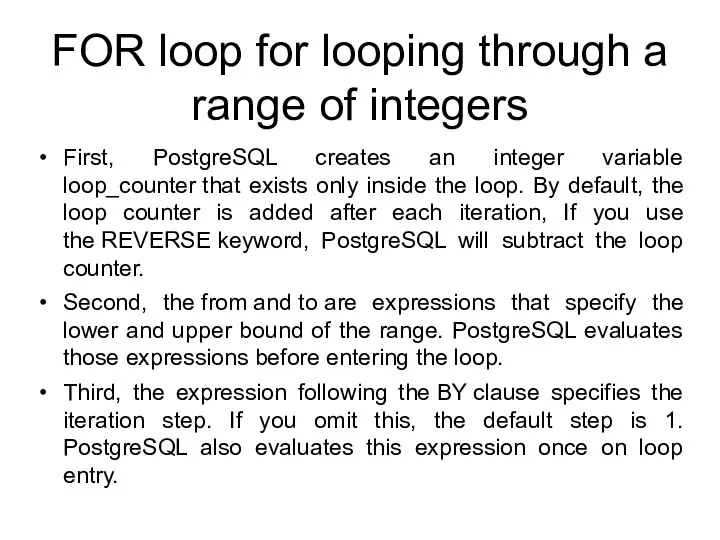
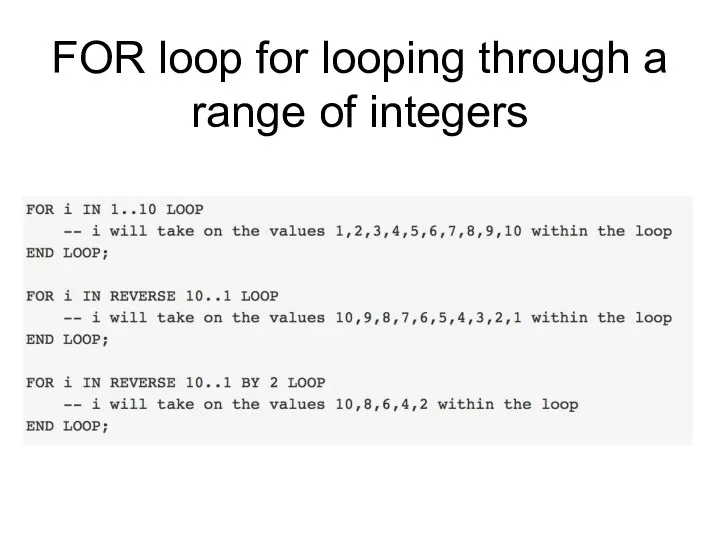
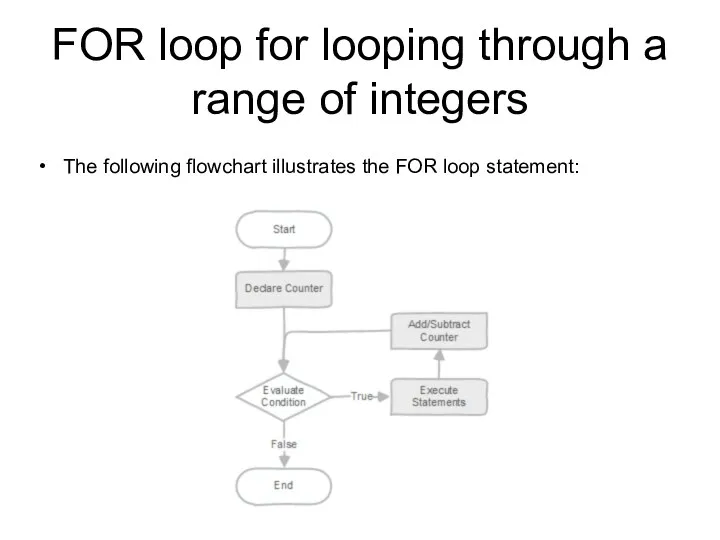
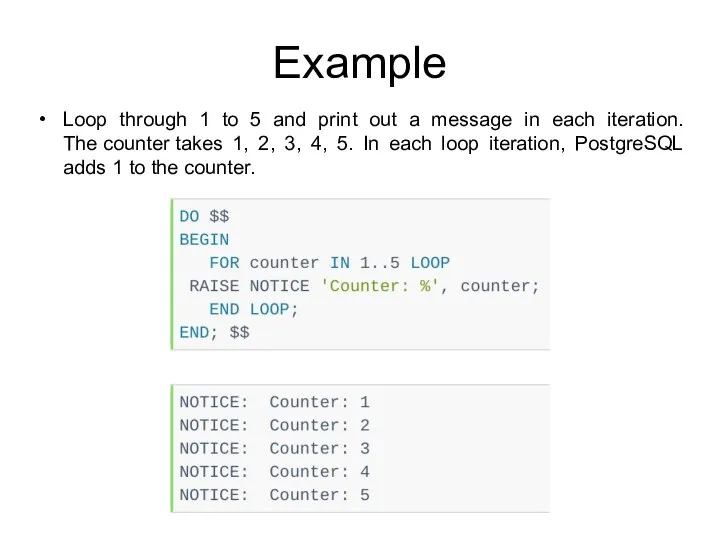
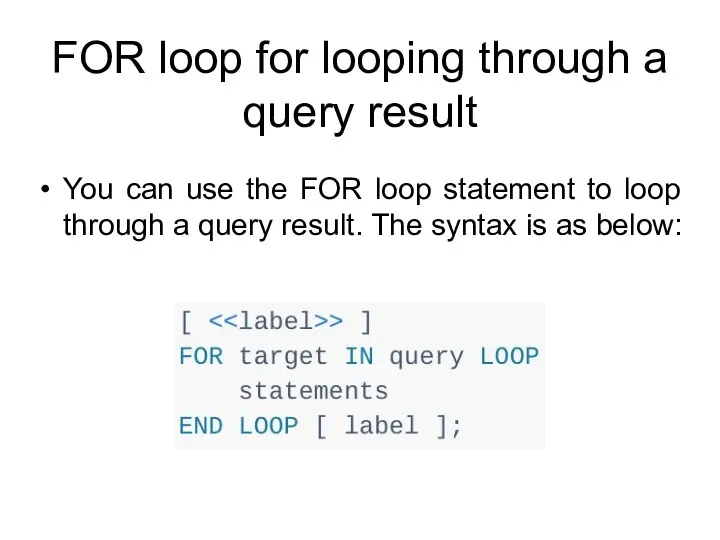
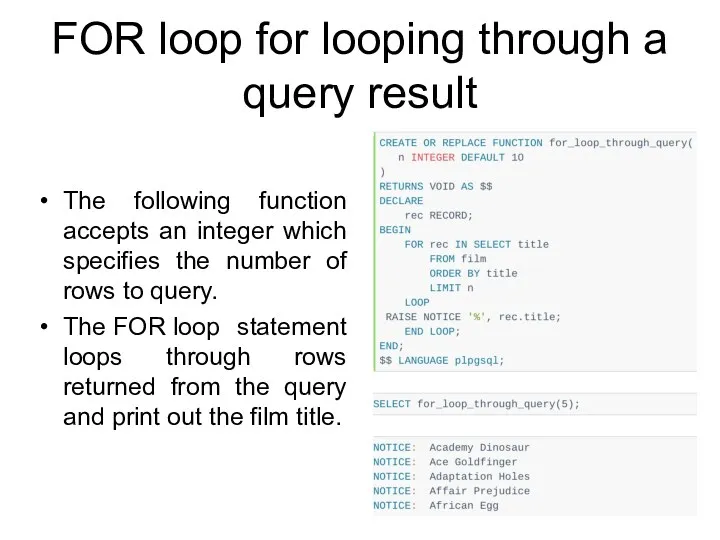
 Тақырып жазу технологиясы
Тақырып жазу технологиясы Арифметические операции в позиционных системах счисления
Арифметические операции в позиционных системах счисления Переключатель. Полоса прокрутки
Переключатель. Полоса прокрутки Графические операторы языка Qbasic
Графические операторы языка Qbasic Базы данных. Информационные системы
Базы данных. Информационные системы Понятие информационной безопасности в РФ
Понятие информационной безопасности в РФ Руководство по переходу на MFT
Руководство по переходу на MFT Привязка личного кабинета на портале услуг к подтвержденной учетной записи ЕСИА. Начисление баллов в рамках конкурса ITчемпион
Привязка личного кабинета на портале услуг к подтвержденной учетной записи ЕСИА. Начисление баллов в рамках конкурса ITчемпион Информатика. Материалы к лекции 5. Пользовательская форма на VBA
Информатика. Материалы к лекции 5. Пользовательская форма на VBA Выполнение геометрических построений в системе компьютерного черчения КОМПАС. Геометрическое построение угла, равного заданному
Выполнение геометрических построений в системе компьютерного черчения КОМПАС. Геометрическое построение угла, равного заданному Общение в эпоху онлайн
Общение в эпоху онлайн Звуковая информация. Временная дискретизация звука
Звуковая информация. Временная дискретизация звука Арифметические основы компьютера
Арифметические основы компьютера Програмний комплекс автоматизації центрів надання адміністративних послуг (Інформаційна система Вулик)
Програмний комплекс автоматизації центрів надання адміністративних послуг (Інформаційна система Вулик) Вычислительная техника в СССР
Вычислительная техника в СССР Компьютерные презентации
Компьютерные презентации Family of Programming Languages
Family of Programming Languages Алгоритмы решения задач. Схемы алгоритмов
Алгоритмы решения задач. Схемы алгоритмов Решение задач на компьютере. Алгоритмизация и программирование (9 класс)
Решение задач на компьютере. Алгоритмизация и программирование (9 класс) Игра как метод решения учебных проблем
Игра как метод решения учебных проблем How did we make the biggest game on Defold in 1 year
How did we make the biggest game on Defold in 1 year Задача о минимальном разрезе на взвешенном бисвязном графе
Задача о минимальном разрезе на взвешенном бисвязном графе Личности в истории информатики. Джон Непер
Личности в истории информатики. Джон Непер 8 класс, урок Информационные процессы в технике.
8 класс, урок Информационные процессы в технике. Информационная безопасность. Методы и средства защиты информации
Информационная безопасность. Методы и средства защиты информации Цифровое портфолио
Цифровое портфолио MrBeast
MrBeast Использование интерактивных методов обучения на уроках математики
Использование интерактивных методов обучения на уроках математики